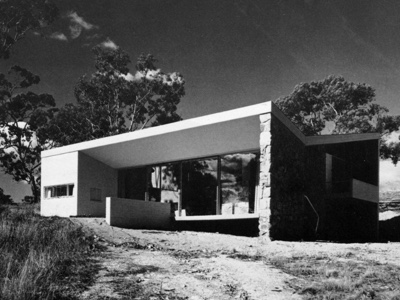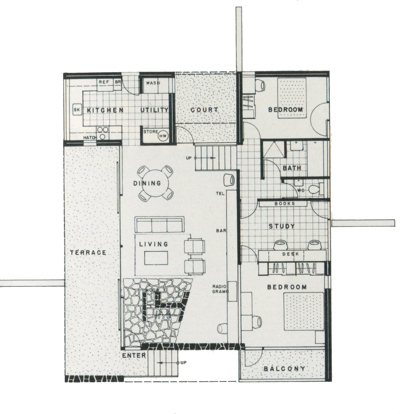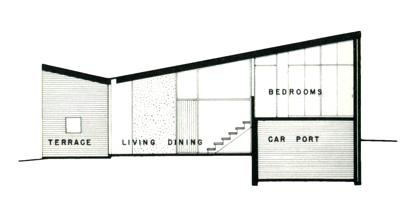11 Northcote Crescent, Deakin (1951-52)

11 Northcote Crescent, Deakin
The Bowden House at 11 Northcote Crescent, Deakin was designed by Harry Seidler and Associates in 1951–52 for Mr I G Bowden. Construction was completed in 1955. The house is an early example of the post-war international style with its cubiform shape, Corbusian window motif, overhang for shade, plain smooth wall surfaces, contrasting textures and large sheets of glass.
The original house was an excellent example of Seidler’s early work in Australia and was probably his first commission outside Sydney. It is one of only two detached houses that Seidler designed in Canberra. The other, at 12 Yapunyah Street, O’Connor, has been demolished. In Seidler’s book ‘Houses, Interiors and Projects’ (Horwitz, 1959), the house is highlighted as an example that demonstrated the design philosophy central to his architecture during this period.
The house is constructed of similar materials and displays the forms and design principles found in the Rose Seidler House at Turramurra (1947–50), the Dr S Fink House at Newport (1949–51) and the Hutter House at Turramurra (1952).
Significance
11 Northcote Crescent, Deakin is listed on the ACT Chapter of the Australian Institute of Architects Register of Significant Twentieth Century Architecture. It is regarded by the AIA as being an important example of Seidler’s early work, being Canberra’s first true example of the rationale of Bauhaus principles. It can be considered to be one of Canberra’s two most significant post-war international style houses (the other being the Round House, at 10 Gawler Crescent, Deakin.
Harry Seidler is one of Australia’s greatest architects and the first architect in Australia to fully express the principles of the Bauhaus. He was awarded the RAIA Gold Medal in 1976 and has designed many of Australia’s most important residential and commercial buildings. The Seidler biography on this site lists a number of these projects.

The original floorplan
Description
The original house was a rectangular split level plan positioned diagonally across the site, which slopes towards the street. The carport is excavated into the site at the lower side under the higher of the split levels. The house is constructed of random stone walls, rendered cavity brickwork, suspended concrete slabs, steel and timber roof framing and a metal deck roof.
The entry is approached up a cantilevered concrete stair with open treads and a simple pipe handrail. The stair is located under the roofline within the cubiform and given prominence by the random stone wall. The front door opens into a random stone paved lobby area behind a quarter height random stone fireplace with a tall, slender white rendered central chimney. The entry is on an axis with and parallel to the full height and full length living room north west glazing. The entry emphasises the positioning of different materials with the play of rough stone with glazing and smooth rendered walls. This was an important aspect of Seidler’s early work.
The split level planning divides the residence into living spaces and rest areas. This design takes advantage of the interplay of horizontal and vertical space with planning themes centred on the living room. The panelled rear wall of the living room separates it from the upper sleeping areas. The room opens out into the north west through full height sliding glass doors to a terrace, which has a wide overhang angled to allow winter sun to penetrate into the room but exclude the hot summer sun.

Western elevation
The upper sleeping level is accessed by an open tread timber stair, echoing the theme of the concrete entry stair. The corridor at this level is a secondary axis parallel to the main axis. Originally there was glazing at both ends of the house that allowed views along the corridor and into the landscape. The axis was emphasised externally by a stone blade wall extending east from the second bedroom, culminating at the west end in the balcony off the main bedroom.
The upper level originally consisted of two bedrooms a study and a bathroom where the ceiling followed the pitch of the roof, as with the lower level. The planning themes involved the external form of the house extending into the landscape via the use of low level walls perpendicular to the perimeter walls of the house and adjacent to the glazing. This is reminiscent of Mies van der Rohe’s designs in the 1920s.
The house has been modified and extended twice: the first time in 1957–60 by Seidler and the second time in 1978 by a local architect. The Seidler work added two bedrooms to the north east, a new laundry and an extension of the kitchen and dining room into the original laundry space and courtyard. The original design aesthetic was maintained with matching wall finishes and roofing, but the upper level planning themes were largely changed by this extension.
Unfortunately the second alterations closed off the internal open view from the main bedroom down to the living room and enclosed the north east facing terrace to increase the size of the dining room. The cantilevered balcony off the main bedroom has also been enclosed, which has changed the appearance of the western facade. This was an important design feature, being an expression of the internal spaces, structure and architectural style.
Source
- Australian Institute of Architects RSTCA Citation No. R111
- Peter Blake, Architecture for the New World. The Work of Harry Seidler, Horwitz, 1973
Acknowledgements
- Photograph of the Bowden House courtesy of Harry Seidler and Associates. Photographer: Max Dupain.